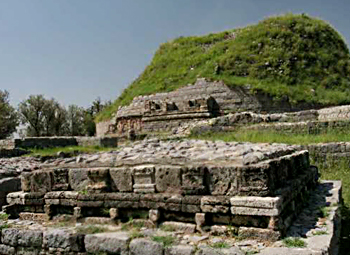 The architecture of Punjab had been immensely influenced by the Buddhist and Islamic styles of architecture. Though Sikhism is the predominant religion of Punjab but it does not have any exclusive architectural pattern of its own. It is a combination of Islam`s Sufism and Hinduism. The place of worship for the Sikhs is known as the Gurudwara. The followers of Sikhism have adopted the Mughal palace style of architecture. Even after independence Punjab has witnessed a steady expansion in architecture.
The architecture of Punjab had been immensely influenced by the Buddhist and Islamic styles of architecture. Though Sikhism is the predominant religion of Punjab but it does not have any exclusive architectural pattern of its own. It is a combination of Islam`s Sufism and Hinduism. The place of worship for the Sikhs is known as the Gurudwara. The followers of Sikhism have adopted the Mughal palace style of architecture. Even after independence Punjab has witnessed a steady expansion in architecture.
History of architecture in Punjab dates back to the Indus valley period when perishable materials like bamboo and wood were used as elements of architecture. Impact of Buddhism is also predominant in the history of architecture of Punjab. A wall surrounded the whole city and there were palaces, high gateways and majestic buildings. But none of these ancient monuments survives in the present day. There are no architectural specimens of the pre- Mauryan period that now exists in Punjab. The earliest examples of architecture in Punjab are those of the Maurya Empire. Islamic architecture became a part of Punjab after the invasion of the Mughals.
Taxila was a famous city during the Maurya period who ruled over undivided Punjab. Archeological evidences suggest that there was three successive phases in the history of the city. There were several Buddhist shrines and stupas in the city. The Dharmarajika Stupa built by emperor Ashoka is the most imperative architectural example of the city. Constructed on an elevated platform of stone the Stupa is circular in design and hemispherical in altitude. Excavation has revealed the existence of Buddhist architecture like stupas, viharas and other buildings in the city of Charsdda in the Peshawar district. The great Stupa at Shahji- Ki- Dheri was built by Kanishka. Sanghol in Ludhiana district represents the location of a Buddhist establishment. Remains of Dharma- chakra- Stupa was found at Sanghol. The Buddhist monasteries of the seventh century were the most outstanding architecture of Punjab.
 The Golden temple of Amritsar is the main place of worship for the Sikhs. During the later half of the 16th century Amritsar became the most important city for the Sikhs. The Golden temple was constructed in the year 1764 and later in 1802 Ranjit Singh established the Sikh kingdom and plated the roof with gold and what was originally Hari Mandir came to be called the Golden Temple. The main building is rather small and is built in the middle of a tank, which gives the appearance of floating on water. The temple, its surrounding precincts made of marble and the water in the tank, all appear pure, different and extraordinary. The central building is designed in the latter Mughal style. The Yadavindra garden at Pinjore is influenced from the open terrace-style Mughal garden. The water canal in the centre of the garden passes through seven open terraces and pavilions and is decorated with chadars and fountains.
The Golden temple of Amritsar is the main place of worship for the Sikhs. During the later half of the 16th century Amritsar became the most important city for the Sikhs. The Golden temple was constructed in the year 1764 and later in 1802 Ranjit Singh established the Sikh kingdom and plated the roof with gold and what was originally Hari Mandir came to be called the Golden Temple. The main building is rather small and is built in the middle of a tank, which gives the appearance of floating on water. The temple, its surrounding precincts made of marble and the water in the tank, all appear pure, different and extraordinary. The central building is designed in the latter Mughal style. The Yadavindra garden at Pinjore is influenced from the open terrace-style Mughal garden. The water canal in the centre of the garden passes through seven open terraces and pavilions and is decorated with chadars and fountains.
The capital city of Chandigarh is a fine architectural creation of the 20th century. The city is divided into forty seven sectors and the focal point is the capital complex and the civic centre. The orderly design, wide roads and well-planned facilities with a leaning towards modernism, make it an ideal `garden city` and a bible for architects. Chandigarh has become a symbol of youth and its people are proud of its state-of-the-art-city status. The urban planning of Chandigarh was done by French architect-planner Le Corbusier. Chandigarh is very different from traditional cities. The terrace garden is a major tourist attraction of Chandigarh. The big sun-screen and the three-dimensional effect, along with the interior spaces, present a suitably fantastic picture, without contradicting traditional Indian architecture. The museum that was built later is a replica of the museum in Ahmedabad and the National Western Museum in Tokyo. The rock garden of Chandigarh resembles the Sam`s Tower in America. This rock-garden was created as a counterbalance to the very functional, geometric city of Chandigarh. It is a rock garden with self-styled, uninhibited sculptures.
From the ancient architecture of Taxila till the present day, the architecture of Punjab has come a long way. Whether it is the Buddhist monuments or the Mughal structural design or the contemporary city of Chandigarh, architectural beauty of Punjab is captivating and awe- inspiring.




